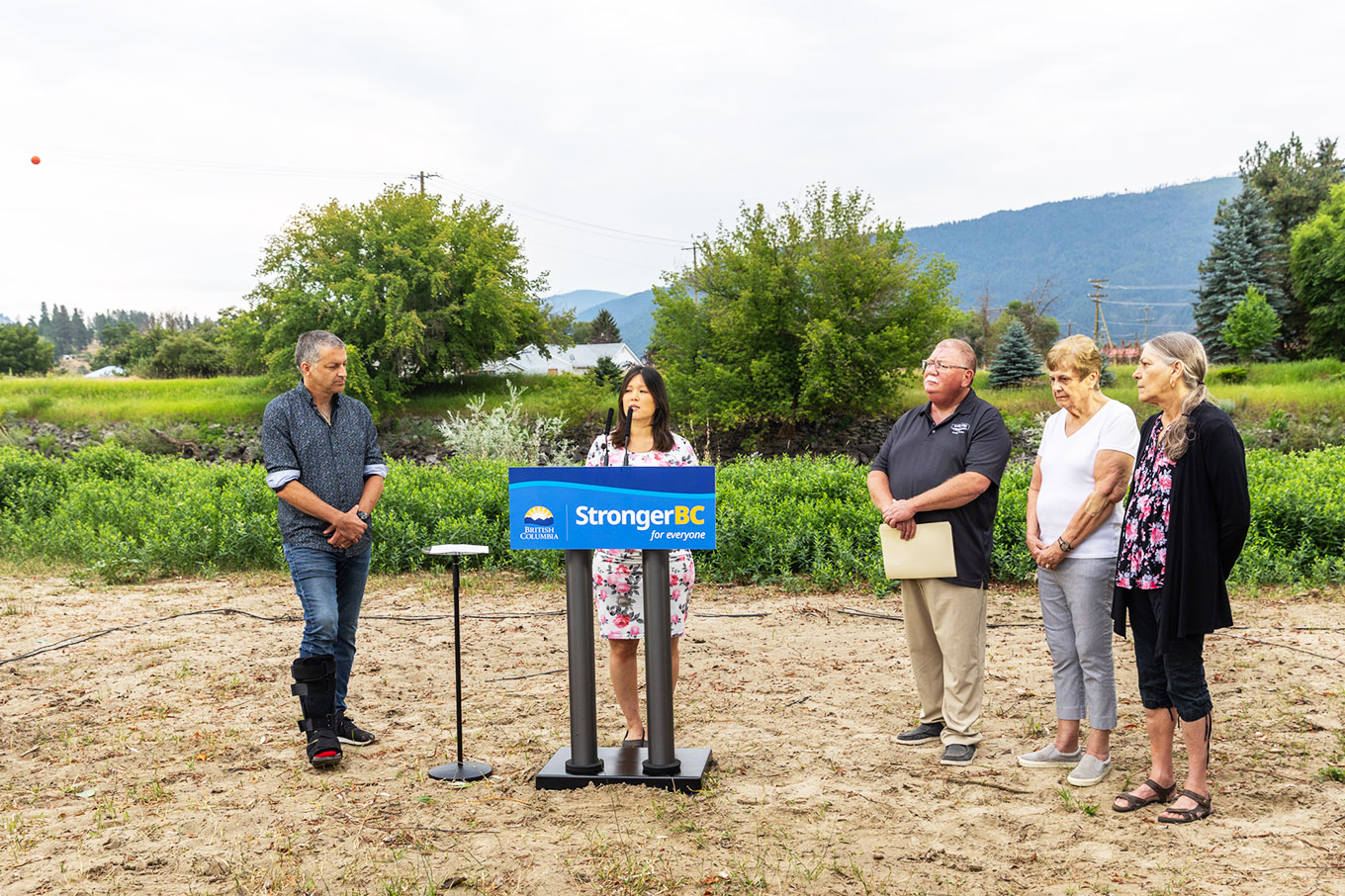B.C. strengthens community preparedness for climate-related disasters
First Nations and local governments throughout B.C. will benefit from funding to help strengthen resilience against climate-related hazards, such as flooding, drought, wildfires and heat.
“With the severe flooding, drought and wildfires we’ve experienced recently, we are seeing direct impacts of climate change here in B.C.,” said Bowinn Ma, Minister of Emergency Management and Climate Readiness Tuesday morning in Grand Forks.
“We’re investing in mitigation projects across the province so we can reduce the risk of disasters when they happen. These projects will help communities better protect themselves against climate-related events and increase their resilience in the long run to keep people across B.C safer.”
The Province is providing more than $44 million through the Community Emergency Preparedness Fund (CEPF), which will go to more than 70 projects in 63 communities under the Disaster Risk Reduction-Climate Adaptation program stream.
These investments also support the Province’s Climate Preparedness and Adaptation Strategy, which outlines a broad range of actions until 2025 to address climate impacts and build resilience across B.C.
Funding may be used toward:
- risk mapping, risk assessments and planning (such as the development of a hazard map);
- land-use planning (amendments to relevant plans, bylaws or policies);
- purchasing equipment (such as monitoring equipment);
- delivering community education;
- small-scale structural projects
More than $1.76 million is being provided to the City of Grand Forks for a flood-mitigation project that includes channel excavation, installation of 82 fish habitat structures and planting 45,000 trees and shrubs along the channel banks and riparian area along the Kettle River.
“Natural assets – things like wetlands and riparian forests – have an enormous role to play in reducing our risk from natural disasters such as flooding and wildfires,” said Roly Russell, MLA for Boundary-Similkameen.
“It's great to see the City of Grand Forks prioritizing investment into these natural assets, and our government is proud to support the city and other communities as they work to mitigate disaster risk.”
The Province’s investment is part of the larger North Ruckle floodplain naturalization and habitat offset project, which will reduce the risk of floods in the city. Approximately 3,000 Boundary-area residents were ordered to evacuate in May 2018 when the Kettle River overflowed its banks.
“Mitigation work completed in Grand Forks since the flood in 2018 has already proved itself fully during this year’s freshet season,” said Everett Baker, mayor of Grand Forks.
“Restoring the floodplain will create important room for the river to flood and this funding will help us meet requirements to replace or restore habitats impacted by dike construction.”
Among the other projects throughout B.C. receiving funding from the CEPF program are:
- installing a waterline and reservoir that will reduce the impacts of drought on the community for the Kanaka Bar Indian Band, including reducing fire risk, as well as social, health, ecosystem and food system stress;
- completing a bank stabilization project that includes a headwall and pond at the outfall of a pipe along the Xget’tem’ Trail in Kamloops, which will prevent further erosion of the trail during rainfall;
- flood risk mitigation planning to help reduce runoff and unpredictable flow paths for the Giants Head Basin, as well as upgrading a spillway for the Isintok Dam to reduce the risk of dam failure during an extreme flooding event in the district of Summerland;
- risk-management practice and policy development for Nelson, including creating a framework for consistent, risk-informed decisions; Nelson’s 2019 hazard, risk and vulnerability analysis (HRVA) identified wildfire, severe weather and extreme weather including drought as the city’s top three hazards;
- raising the Mountview Dike alongside the Elk River to flood construction levels to prevent flooding in Fernie; and
- completing risk mapping, a risk assessment and a mitigation and response plan for Metchosin specific to shoreline erosion, flooding, drought implications and increasing storm severity.
In February 2023, the Province provided $180 million to CEPF, bringing the total provincial investment in the program to $369 million since its establishment in 2017. More than $163 million has been provided to First Nations and local governments through CEPF for over 1,500 projects that help communities mitigate and prepare for disasters and climate-related emergencies. The CEPF is administered by the Union of BC Municipalities on behalf of the Province.
In response to the growing number of climate-related emergencies in B.C., the Province also launched ClimateReadyBC, which provides hazard and mapping tools, risk data and resources to help communities better prepare for future disasters and climate emergencies.
Intake for the current Disaster Risk Reduction-Climate Adaptation program stream is open until Oct. 6, 2023.
Learn More:
- For information about the Community Emergency Preparedness Fund, visit: https://www.ubcm.ca/cepf
- For information about disaster and climate-risk reduction, visit ClimateReadyBC: https://www.ClimateReadyBC.ca
- To learn about the Climate Preparedness and Adaptation Strategy, visit: http://www.gov.bc.ca/BC-Adapts
- To learn about the City of Grand Forks, visit: https://www.grandforks.ca

From left,Roly Russell, MLA for Boundary-Similkameen, Bowinn Ma, Minister of Emergency Management and Climate Readiness, Grand Forks Mayor Everett Baker and councillors Christine Thompson and Deborah Lafleur are photographed following the announcement Tuesday in Grand Forks. — Photo courtesy Province of BC


























